C. Bayan Bruss
Center for Machine Learning, Capital One
BEDTime: A Unified Benchmark for Automatically Describing Time Series
Sep 05, 2025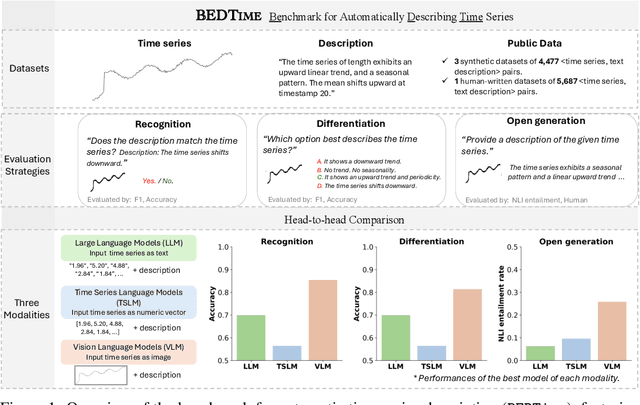

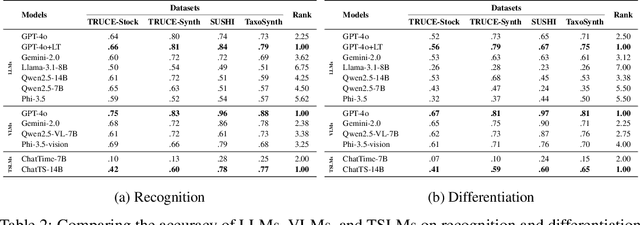
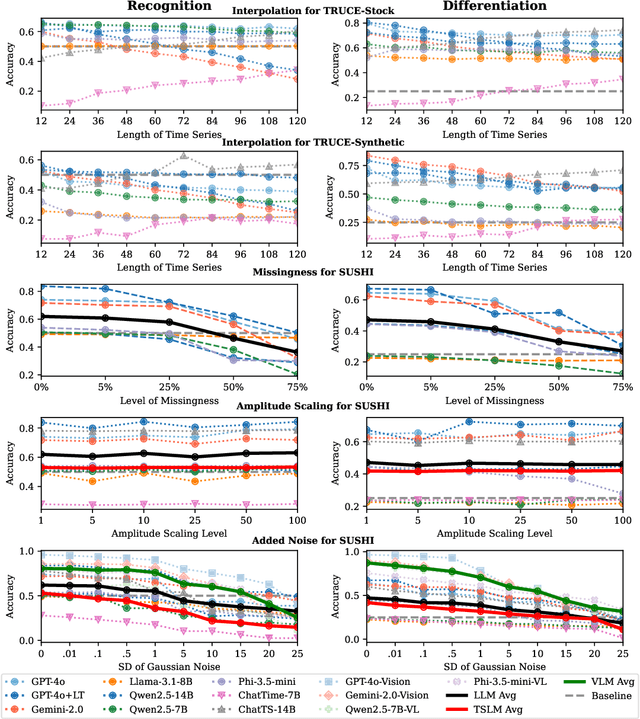
Abstract:Many recent studies have proposed general-purpose foundation models designed for a variety of time series analysis tasks. While several established datasets already exist for evaluating these models, previous works frequently introduce their models in conjunction with new datasets, limiting opportunities for direct, independent comparisons and obscuring insights into the relative strengths of different methods. Additionally, prior evaluations often cover numerous tasks simultaneously, assessing a broad range of model abilities without clearly pinpointing which capabilities contribute to overall performance. To address these gaps, we formalize and evaluate 3 tasks that test a model's ability to describe time series using generic natural language: (1) recognition (True/False question-answering), (2) differentiation (multiple choice question-answering), and (3) generation (open-ended natural language description). We then unify 4 recent datasets to enable head-to-head model comparisons on each task. Experimentally, in evaluating 13 state-of-the-art language, vision--language, and time series--language models, we find that (1) popular language-only methods largely underperform, indicating a need for time series-specific architectures, (2) VLMs are quite successful, as expected, identifying the value of vision models for these tasks and (3) pretrained multimodal time series--language models successfully outperform LLMs, but still have significant room for improvement. We also find that all approaches exhibit clear fragility in a range of robustness tests. Overall, our benchmark provides a standardized evaluation on a task necessary for time series reasoning systems.
Out-of-Distribution Detection Methods Answer the Wrong Questions
Jul 02, 2025Abstract:To detect distribution shifts and improve model safety, many out-of-distribution (OOD) detection methods rely on the predictive uncertainty or features of supervised models trained on in-distribution data. In this paper, we critically re-examine this popular family of OOD detection procedures, and we argue that these methods are fundamentally answering the wrong questions for OOD detection. There is no simple fix to this misalignment, since a classifier trained only on in-distribution classes cannot be expected to identify OOD points; for instance, a cat-dog classifier may confidently misclassify an airplane if it contains features that distinguish cats from dogs, despite generally appearing nothing alike. We find that uncertainty-based methods incorrectly conflate high uncertainty with being OOD, while feature-based methods incorrectly conflate far feature-space distance with being OOD. We show how these pathologies manifest as irreducible errors in OOD detection and identify common settings where these methods are ineffective. Additionally, interventions to improve OOD detection such as feature-logit hybrid methods, scaling of model and data size, epistemic uncertainty representation, and outlier exposure also fail to address this fundamental misalignment in objectives. We additionally consider unsupervised density estimation and generative models for OOD detection, which we show have their own fundamental limitations.
Explain What You Mean: Intent Augmented Knowledge Graph Recommender Built With LLM
May 16, 2025Abstract:Interaction sparsity is the primary obstacle for recommendation systems. Sparsity manifests in environments with disproportional cardinality of groupings of entities, such as users and products in an online marketplace. It also is found for newly introduced entities, described as the cold-start problem. Recent efforts to mitigate this sparsity issue shifts the performance bottleneck to other areas in the computational pipeline. Those that focus on enriching sparse representations with connectivity data from other external sources propose methods that are resource demanding and require careful domain expert aided addition of this newly introduced data. Others that turn to Large Language Model (LLM) based recommenders will quickly encounter limitations surrounding data quality and availability. In this work, we propose LLM-based Intent Knowledge Graph Recommender (IKGR), a novel framework that leverages retrieval-augmented generation and an encoding approach to construct and densify a knowledge graph. IKGR learns latent user-item affinities from an interaction knowledge graph and further densifies it through mutual intent connectivity. This addresses sparsity issues and allows the model to make intent-grounded recommendations with an interpretable embedding translation layer. Through extensive experiments on real-world datasets, we demonstrate that IKGR overcomes knowledge gaps and achieves substantial gains over state-of-the-art baselines on both publicly available and our internal recommendation datasets.
Just How Flexible are Neural Networks in Practice?
Jun 17, 2024Abstract:It is widely believed that a neural network can fit a training set containing at least as many samples as it has parameters, underpinning notions of overparameterized and underparameterized models. In practice, however, we only find solutions accessible via our training procedure, including the optimizer and regularizers, limiting flexibility. Moreover, the exact parameterization of the function class, built into an architecture, shapes its loss surface and impacts the minima we find. In this work, we examine the ability of neural networks to fit data in practice. Our findings indicate that: (1) standard optimizers find minima where the model can only fit training sets with significantly fewer samples than it has parameters; (2) convolutional networks are more parameter-efficient than MLPs and ViTs, even on randomly labeled data; (3) while stochastic training is thought to have a regularizing effect, SGD actually finds minima that fit more training data than full-batch gradient descent; (4) the difference in capacity to fit correctly labeled and incorrectly labeled samples can be predictive of generalization; (5) ReLU activation functions result in finding minima that fit more data despite being designed to avoid vanishing and exploding gradients in deep architectures.
Simplifying Neural Network Training Under Class Imbalance
Dec 05, 2023



Abstract:Real-world datasets are often highly class-imbalanced, which can adversely impact the performance of deep learning models. The majority of research on training neural networks under class imbalance has focused on specialized loss functions, sampling techniques, or two-stage training procedures. Notably, we demonstrate that simply tuning existing components of standard deep learning pipelines, such as the batch size, data augmentation, optimizer, and label smoothing, can achieve state-of-the-art performance without any such specialized class imbalance methods. We also provide key prescriptions and considerations for training under class imbalance, and an understanding of why imbalance methods succeed or fail.
A Performance-Driven Benchmark for Feature Selection in Tabular Deep Learning
Nov 10, 2023



Abstract:Academic tabular benchmarks often contain small sets of curated features. In contrast, data scientists typically collect as many features as possible into their datasets, and even engineer new features from existing ones. To prevent overfitting in subsequent downstream modeling, practitioners commonly use automated feature selection methods that identify a reduced subset of informative features. Existing benchmarks for tabular feature selection consider classical downstream models, toy synthetic datasets, or do not evaluate feature selectors on the basis of downstream performance. Motivated by the increasing popularity of tabular deep learning, we construct a challenging feature selection benchmark evaluated on downstream neural networks including transformers, using real datasets and multiple methods for generating extraneous features. We also propose an input-gradient-based analogue of Lasso for neural networks that outperforms classical feature selection methods on challenging problems such as selecting from corrupted or second-order features.
From Explanation to Action: An End-to-End Human-in-the-loop Framework for Anomaly Reasoning and Management
Apr 06, 2023



Abstract:Anomalies are often indicators of malfunction or inefficiency in various systems such as manufacturing, healthcare, finance, surveillance, to name a few. While the literature is abundant in effective detection algorithms due to this practical relevance, autonomous anomaly detection is rarely used in real-world scenarios. Especially in high-stakes applications, a human-in-the-loop is often involved in processes beyond detection such as verification and troubleshooting. In this work, we introduce ALARM (for Analyst-in-the-Loop Anomaly Reasoning and Management); an end-to-end framework that supports the anomaly mining cycle comprehensively, from detection to action. Besides unsupervised detection of emerging anomalies, it offers anomaly explanations and an interactive GUI for human-in-the-loop processes -- visual exploration, sense-making, and ultimately action-taking via designing new detection rules -- that help close ``the loop'' as the new rules complement rule-based supervised detection, typical of many deployed systems in practice. We demonstrate \method's efficacy through a series of case studies with fraud analysts from the financial industry.
BASED-XAI: Breaking Ablation Studies Down for Explainable Artificial Intelligence
Jul 12, 2022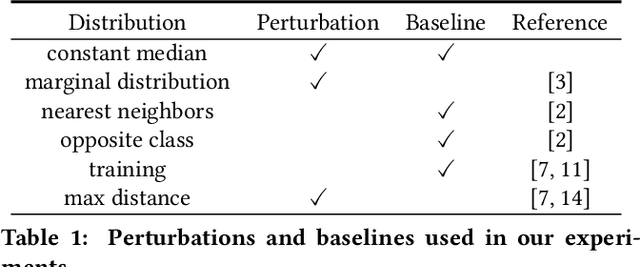

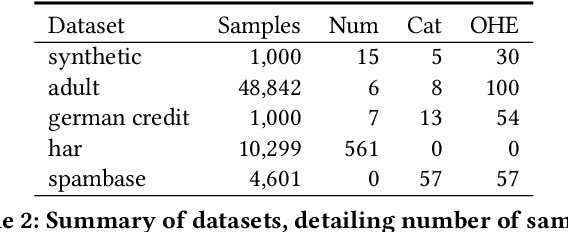
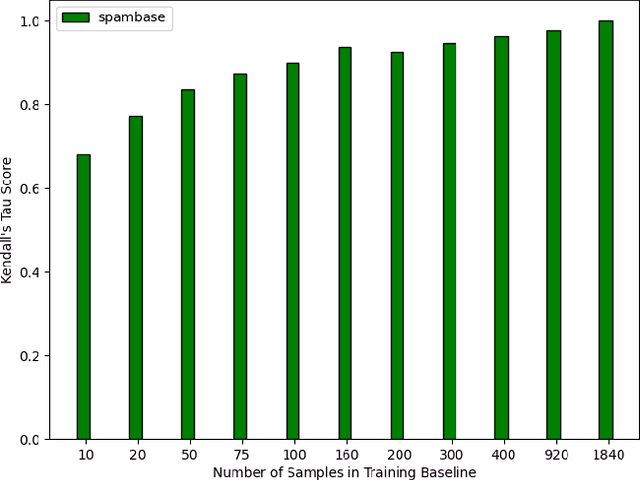
Abstract:Explainable artificial intelligence (XAI) methods lack ground truth. In its place, method developers have relied on axioms to determine desirable properties for their explanations' behavior. For high stakes uses of machine learning that require explainability, it is not sufficient to rely on axioms as the implementation, or its usage, can fail to live up to the ideal. As a result, there exists active research on validating the performance of XAI methods. The need for validation is especially magnified in domains with a reliance on XAI. A procedure frequently used to assess their utility, and to some extent their fidelity, is an ablation study. By perturbing the input variables in rank order of importance, the goal is to assess the sensitivity of the model's performance. Perturbing important variables should correlate with larger decreases in measures of model capability than perturbing less important features. While the intent is clear, the actual implementation details have not been studied rigorously for tabular data. Using five datasets, three XAI methods, four baselines, and three perturbations, we aim to show 1) how varying perturbations and adding simple guardrails can help to avoid potentially flawed conclusions, 2) how treatment of categorical variables is an important consideration in both post-hoc explainability and ablation studies, and 3) how to identify useful baselines for XAI methods and viable perturbations for ablation studies.
Transfer Learning with Deep Tabular Models
Jun 30, 2022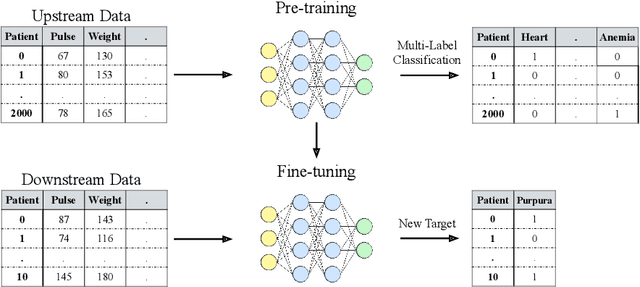
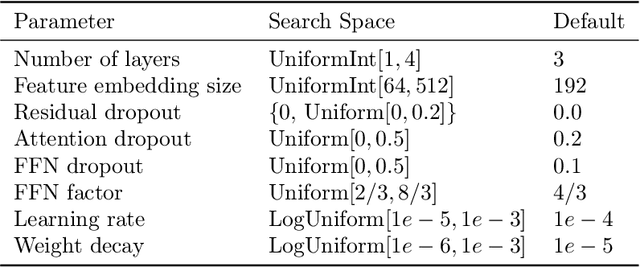


Abstract:Recent work on deep learning for tabular data demonstrates the strong performance of deep tabular models, often bridging the gap between gradient boosted decision trees and neural networks. Accuracy aside, a major advantage of neural models is that they learn reusable features and are easily fine-tuned in new domains. This property is often exploited in computer vision and natural language applications, where transfer learning is indispensable when task-specific training data is scarce. In this work, we demonstrate that upstream data gives tabular neural networks a decisive advantage over widely used GBDT models. We propose a realistic medical diagnosis benchmark for tabular transfer learning, and we present a how-to guide for using upstream data to boost performance with a variety of tabular neural network architectures. Finally, we propose a pseudo-feature method for cases where the upstream and downstream feature sets differ, a tabular-specific problem widespread in real-world applications. Our code is available at https://github.com/LevinRoman/tabular-transfer-learning .
Counterfactual Explanations via Latent Space Projection and Interpolation
Dec 02, 2021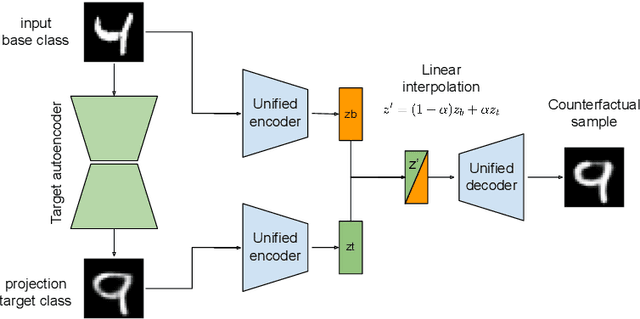

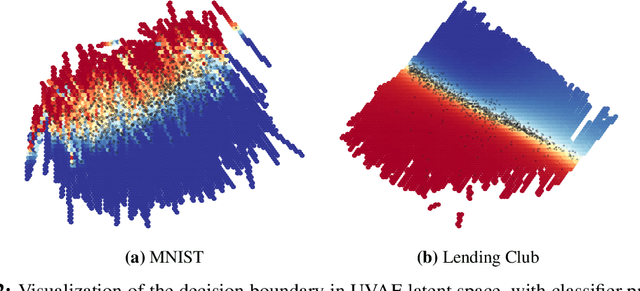

Abstract:Counterfactual explanations represent the minimal change to a data sample that alters its predicted classification, typically from an unfavorable initial class to a desired target class. Counterfactuals help answer questions such as "what needs to change for this application to get accepted for a loan?". A number of recently proposed approaches to counterfactual generation give varying definitions of "plausible" counterfactuals and methods to generate them. However, many of these methods are computationally intensive and provide unconvincing explanations. Here we introduce SharpShooter, a method for binary classification that starts by creating a projected version of the input that classifies as the target class. Counterfactual candidates are then generated in latent space on the interpolation line between the input and its projection. We then demonstrate that our framework translates core characteristics of a sample to its counterfactual through the use of learned representations. Furthermore, we show that SharpShooter is competitive across common quality metrics on tabular and image datasets while being orders of magnitude faster than two comparable methods and excels at measures of realism, making it well-suited for high velocity machine learning applications which require timely explanations.
 Add to Chrome
Add to Chrome Add to Firefox
Add to Firefox Add to Edge
Add to Edge